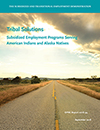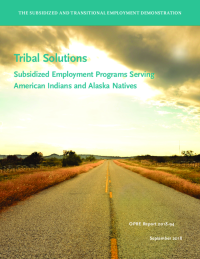Tribal Solutions
Subsidized Employment Programs Serving American Indians and Alaska Natives

 People served by public assistance programs such as Temporary Assistance for Needy Families (TANF) often have difficulty finding jobs in the competitive labor market. The unemployment rate for American Indian and Alaska Native (AIAN) individuals is consistently higher than for any other racial group in the United States, and many AIAN communities face substantial barriers to employment.
People served by public assistance programs such as Temporary Assistance for Needy Families (TANF) often have difficulty finding jobs in the competitive labor market. The unemployment rate for American Indian and Alaska Native (AIAN) individuals is consistently higher than for any other racial group in the United States, and many AIAN communities face substantial barriers to employment.
To address these barriers, some Tribal TANF programs have implemented subsidized employment programs designed to increase both participants’ income and their employability. Subsidized employment programs rely on public funds to subsidize the wages that employers pay when they provide jobs to individuals who cannot find them in the competitive labor market. Programs can be used to create jobs in areas where there are more people interested in work than there are available jobs. They can also help individuals with barriers to employment gain work experience while earning income. This report describes the ways in which eight TANF programs primarily serving AIAN families use subsidized employment, as well as the contexts in which they operate.
Key Findings
-
Subsidized employment has the potential to provide work opportunities for individuals in AIAN families with limited work experience and barriers to employment. Tribal and state TANF programs are using an array of strategies to engage AIAN families in subsidized employment. Along with income, these positions provide opportunities to build work experience, job skills, and marketability in the competitive labor market.
-
The local and economic context of the service area influences the approach state and Tribal TANF programs take in implementing subsidized employment. In areas with more limited job availability, subsidized employment functions as an opportunity to provide TANF participants with a temporary job that may also benefit the local community. However, the broader limitations of the local economy minimize opportunities for their transition to unsubsidized employment. When the local economy is larger and more diverse, programs place a heavier emphasis on positions that can lead to unsubsidized employment.
With 70 Tribal TANF programs operating across the country, these 8 programs are not representative. Instead, they offer examples of the ways in which Tribal TANF programs can provide employment opportunities to participants. These programs have each taken distinct approaches to designing and implementing subsidized employment programs, reflecting the unique strengths and needs of their participants and communities. However, their collective experience suggests that subsidized employment can increase participants’ income in the near term, can give them practical work experience, and can help support the operation of essential tribal programs.






